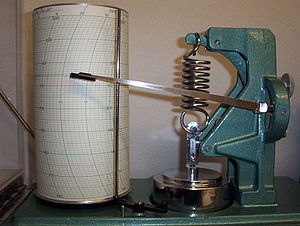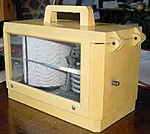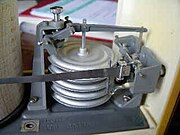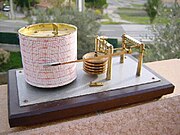Difference between revisions of "AY Honors/Weather - Advanced/Answer Key"
m (55 revisions from w:Barograph) |
m (Transwiki:Barograph moved to AY Honor Weather - Advanced: transwiki merge) |
(No difference)
| |
Revision as of 01:15, 5 December 2007
A barograph is a recording aneroid barometer. It produces a paper or foil chart called a barogram that records the barometric pressure over time.
Barographs use one or more aneroid cells acting through a gear or lever train to drive a recording arm that has at its extreme end either a scribe or a pen. A scribe records on smoked foil while a pen records on paper. The recording material is mounted on a cylindrical drum which is rotated slowly by clockwork. Commonly, the drum makes one revolution per day, per week, or per month and the rotation rate can often be selected by the user.
Because the amount of movement that can be generated by a single aneroid is minuscule, up to seven aneroids (so called Vidie-cans) are often stacked "in series" to amplify their motion. It was invented in 1843 by the Frenchman Lucien Vidie (1805-1866).
As atmospheric pressure responds in a predictable manner to changes in altitude, barographs may be used to record elevation changes during an aircraft flight. Barographs were required by the FAI to record certain tasks and record attempts associated with sailplanes. A continuously varying trace indicated that the sailplane had not landed during a task, while measurements from a calibrated trace could be used to establish the completion of altitude tasks or the setting of records. Examples of FAI approved sailplane barographs included the Replogle mechanical drum barograph and the EW electronic barograph (which may be used in conjunction with GPS). Mechanical barographs are not commonly used for flight documentation now, having been displaced by GNSS Flight Recorders.
Nowadays, mechanical recording barographs have commonly been superseded by electronic weather instruments that use computer methods to record the barometric pressure. These are not only less expensive than mechanical barographs but they may also offer both greater recording length and the ability to perform further data analysis on the captured data including automated use of the data to forecast the weather.
Three-day barograph

On the top right of the picture of the three day barograph can be seen a silver knurled knob. This is to adjust the barograph so that it correctly reflects the station pressure. Barely visible below the knob is a small silver plunger. This is pressed every three hours to leave a time mark on the paper.
The line between two of these marks is called the 'characteristic of barometric tendency' and is used by weather forecasters. The observer would first note if the pressure was lower or higher than three hours prior. Next, a code number would be chosen that best represents the three hour trace. There are nine possible choices (0 to 8) and no single code has preference over another. In the case of the graph on the barograph, one of two codes could be picked. An 8 (steady then decreasing) or 6 (decreasing then steady). The observer should pick the 6 because it represents the last part of the trace and is thus most representative of the pressure change.
In the bottom centre is the aneroid (large circular silver object). As the pressure increases the aneroid is pushed down causing the arm to move up and leave a trace on the paper. As the pressure decreases the spring lifts the aneroid and the arm moves down.
After three days the drum to which the graph is attached is removed. At this point the clockwork motor is wound and if necessary corrections can be made to increase or decrease the speed and new chart is attached.
Images of barographs
 Sailplane barograph in its case |
cs:Barograf de:Barograph pl:Barograf ru:Барограф sv:Barograf uk:Барограф


